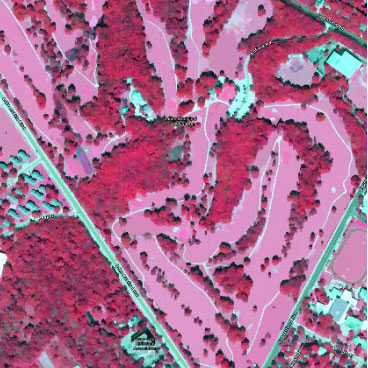Isoprene and other biogenic volatile organic compounds (BVOCs) strongly influence atmospheric chemistry in the Wasatch Front region and can dominate the total VOC reactivity of at least some Wasatch urban locations. Urban areas are the most challenging for BVOC emissions estimation, due to heterogeneity and a lack of vegetation information, and yet they continue to be the least studied. Two widely used biogenic emission models, the Model of Emissions of Gases and Aerosols from Nature (MEGAN) and the Biogenic Emission Inventory System (BEIS), have used generic national average vegetation characteristic data (e.g., leaf area, tree cover fraction and species composition) to represent urban landscapes that vary over an order of magnitude which results in uncertainty in the Wasatch Front region BVOC estimates. Increasingly higher resolution remote sensing data products have substantially improved the potential for characterizing the landcover inputs required for biogenic emission models.
The overall goal of this project is to improve numerical predictions of regional ozone and aerosol distributions in the Wasatch Front by developing more accurate estimates of BVOC emissions for the urban areas within this region. We have successfully developed and applied approaches for improving MEGAN urban BVOC emission estimates in Texas (Shah et al. 2021) and California (Gu et al. 2021) by analyzing high-resolution (<10 meter) satellite imagery using machine learning, object-based classifications that are calibrated and assessed by field observations. We propose to apply the techniques to improve MEGAN landcover inputs for the Wasatch Front region including time-varying Leaf Area Index (LAI), growth form fractions (tree, shrub, crops, herbaceous plants) and tree species composition (e.g., relative abundance of oaks, poplars, pines, spruce, etc).
The benefit of this project will be an improved MEGAN emission model for the Wasatch Front that is available for use in air quality models that are critical for scientific understanding and the development of regulatory strategies to improve and maintain clean air. The proposed work directly addresses the FY2023 Science for Solutions Research Grant solicitation by targeting a couple of research priorities: (1) Trends, sources and chemistry: Biogenic VOCs, and (2) Emission Inventory Improvements: magnitude of emissions from biogenics.
- Principal Investigator: Tejas Shah (Ramboll US Consulting)
- Study period: 1 July 2022 – 30 September 2023
- Funded by Science for Solutions Research Grant: $124,797
- DAQ Contact: Chris Pennell ([email protected])

